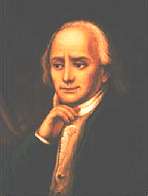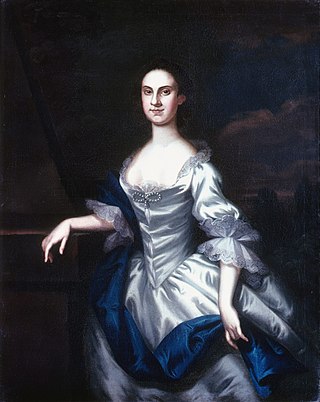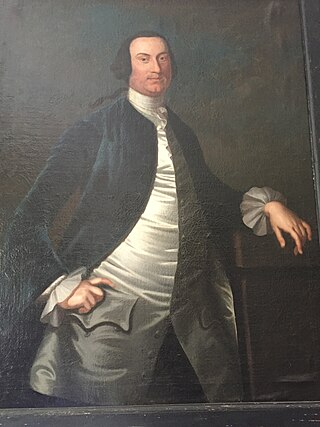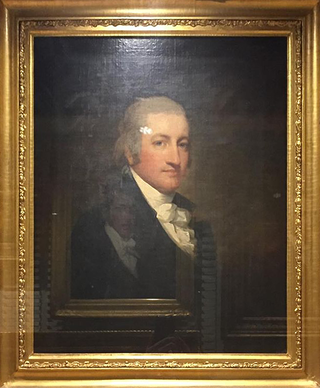
Richmond County is a county located on the Northern Neck in the U.S. state of Virginia. As of the 2020 census, the population sits at 8,923. Its county seat is Warsaw. The rural county should not be confused with the large city and state capital Richmond, Virginia. It was formed in 1692 when the first Rappahannock County was divided to form Richmond County and Essex County.

Warsaw is an incorporated town in and the county seat of Richmond County, Virginia, United States. The population was 1,637 at the 2020 census and is estimated to be 2,281 as of 2022.

Montross is a town in Westmoreland County, Virginia, United States. The population was 553 at the 2020 census. It is the county seat of Westmoreland County. Located in the historic Northern Neck of Virginia, Montross is near the George Washington Birthplace National Monument and the Stratford Hall Plantation. The town's slogan is return to the village.

Francis Lightfoot Lee was a Founding Father of the United States and a member of the House of Burgesses in the Colony of Virginia. As an active protester regarding issues such as the Stamp Act of 1765, Lee helped move the colony in the direction of independence from Britain. Lee was a delegate to the Virginia Conventions and the Continental Congress. He was a signer of the Declaration of Independence and Articles of Confederation as a representative of Virginia. In addition to his career in politics, Lee owned a tobacco plantation as well as many slaves. He was a member of the Lee family, a prominent Virginian dynasty.

The Northern Neck is the northernmost of three peninsulas on the western shore of the Chesapeake Bay in the Commonwealth of Virginia. The Potomac River forms the northern boundary of the peninsula; the Rappahannock River demarcates it on the south. The land between these rivers was formed into Northumberland County in 1648, prior to the creation of Westmoreland County and Lancaster County. The Northern Neck encompasses the following Virginia counties: Lancaster, Northumberland, Richmond, King George and Westmoreland; it had a total population of 50,158 as of the 2020 census.

First Families of Virginia (FFV) were those families in colonial Virginia who were socially prominent and wealthy, but not necessarily the earliest settlers. They descended from English colonists who primarily settled at Jamestown, Williamsburg, the Northern Neck and along the James River and other navigable waters in Virginia during the 17th century. These elite families generally married within their social class for many generations and, as a result, most surnames of First Families date to the colonial period.

Frances Tasker Carter was born in Annapolis, Maryland. Her parents were Benjamin Tasker and Ann Bladen. Benjamin was one of the richest men in the Province of Maryland and a president of the Maryland Council and Provincial Governor of Maryland.

The Octagon House, also known as the Colonel John Tayloe III House, is a house located at 1799 New York Avenue, Northwest in the Foggy Bottom neighborhood of Washington, D.C. It was built in 1799 for John Tayloe III, the wealthiest planter in the country, at the behest of his new family member, George Washington. In September 1814, after the British destroyed the White House during the War of 1812, for six months the Octagon House served as the residence of United States president James Madison and first lady Dolley Madison. It is one of only five houses to serve as the presidential residence in the history of the United States of America, and one of only three that still stand.

William Buckland (1734–1774) was a British architect who designed several important buildings in colonial Maryland and Virginia.

Mount Airy, near Warsaw in Richmond County, Virginia, is the first neo-Palladian villa mid-Georgian plantation house built in the United States. It was constructed in 1764 for Colonel John Tayloe II, perhaps the richest Virginia planter of his generation, upon the burning of his family's older house. John Ariss is the attributed architect and builder. Tayloe's daughter, Rebecca and her husband Francis Lightfoot Lee, one of the only pair of brothers to sign the Declaration of Independence are buried on the estate, as are many other Tayloes. Before the American Civil War, Mount Airy was a prominent racing horse stud farm, as well as the headquarters of about 10-12 separate but interdependent slave plantations along the Rappahannock River. Mount Airy is listed on the National Register of Historic Places as a National Historic Landmark as well as on the Virginia Landmarks Register and is still privately owned by Tayloe's descendants.

Sabine Hall is a historic house located near Warsaw in Richmond County, Virginia. Built about 1730 by noted planter, burgess and patriot Landon Carter (1710–1778), it is one of Virginia's finest Georgian brick manor houses. Numerous descendants served in the Virginia General Assembly. It was added to the National Register of Historic Places in 1969, and declared a National Historic Landmark in 1970. At the time of its National Register listing, it was still owned by Carter / Wellford descendants.

Colonel John Tayloe II was the premier Virginia planter; a politician, and colonial Colonel in the Virginia Militia. Virginia. He served in public office including the Virginia Governor's Council, also known as the Virginia Council of State.

Col. John Tayloe I was one of the richest plantation owners and businessmen in Virginia for his generation. Considered to be the chief architect of the family fortune, he was known as the "Hon. Colonel of the Old House". The Tayloe family of Richmond County, Virginia, including John Tayloe I, his son, John Tayloe II, and grandson, John Tayloe III, exemplified gentry entrepreneurship diversifying business interests through vertical integration.

John Tayloe III, of Richmond County, Virginia, was the premier Virginia planter; a politician, businessman, and tidewater gentry scion. He was prominent in elite social circles. A highly successful planter and early Thoroughbred horse breeder, he was considered the "wealthiest man of his day". A military officer, he also served in the Virginia House of Delegates and Senate of Virginia for nine years.

Powhatan Rural Historic District, formerly "Powhatan Hill Plantation" and before that "Hopyard Plantation", is a national historic district located near King George, King George County, Virginia. It encompasses 15 contributing buildings, 1 contributing site, and 3 contributing structures in a rural area near King George. The district represents a significant reassemblage of the land holdings of Edward Thornton Tayloe, a member of the U.S. diplomatic service under Joel Roberts Poinsett, in the mid-19th century and one of Virginia's most affluent planters of that era; who inherited it from his father John Tayloe III, who built The Octagon House in Washington DC, and it was known then as 'Hopyard,' he inherited it from his father John Tayloe II who built the grand colonial estate Mount Airy. It contains three distinct historic residential farm clusters as well as two post-1950 stable complexes and several other auxiliary residential and agricultural buildings. The main house, known as Powhatan, is sited prominently on a ridge overlooking the Rappahannock River valley.

William Tayloe Murphy Jr. was a Virginia lawyer and Democratic politician who served part time as a member of the Virginia House of Delegates, representing District 99 between 1982 and 2000, as well as Secretary of Natural Resources under Governor Mark Warner from 2002-2006.
William Tayloe or Teylow (1645–1710) was the nephew of William Tayloe of King's Creek Plantation and High Sheriff of York County, Virginia, the father of John Tayloe I of The Old House and progenitor of the Tayloes of Mount Airy, Richmond County, Virginia. His coat of arms, Vert a sword erect Or between two lions rampant addorsed Ermine, matches those of Teylow in Gloucester, England.

Henry Corbin was an emigrant from England who became a tobacco planter in the Virginia colony and served in both houses of the Virginia General Assembly, in the House of Burgesses representing Lancaster County before the creation of Middlesex County on Virginia's Middle Neck, then on the Governor's Council.

Hannah Harrison Ludwell Lee was an American colonial heiress and the wife of Colonel Thomas Lee. A granddaughter of Philip Ludwell and Benjamin Harrison II, she was a prominent figure within the American gentry. She grew up at Green Spring Plantation, her family's home in James City County. Upon her marriage, she became a member of the Lee family, bringing a large dowry and social prestige to the family. With her dowry, she and her husband built Stratford Hall, the family seat of the Lees.
Robert Wormeley Carter was a Virginia planter and patriot who served in the House of Burgesses, all five Virginia Revolutionary Conventions, and briefly in the Virginia House of Delegates, all representing his native Richmond County.






















